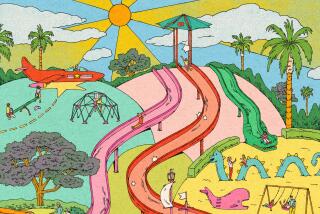The Latest Equipment Will Play Right Into Children’s Hands
- Share via
One minute it’s a pirate ship. No--it’s a tree that offers safety from wild animals lurking in the bushes. Now it’s a castle that must be protected from an advancing army. Or perhaps it’s a challenging mountain to climb.
What most adults see is playground equipment, but to children, those slides, swings and rope ladders offer challenging ways to stimulate their creativity, as well as exercise their bodies.
Adults who have grown tired of hearing a chorus of electronic beeps, or are chagrined by national fitness reports that show children increasingly growing slower and weaker, are rediscovering the joy and value of good old-fashioned swings and slides. But playground equipment today offers far more choices than a tire hanging from a rope.
In his job as park planner for the city of Anaheim, Dick Mayer oversees the planning and development of 39 parks within the city’s boundaries. As a planner for more than 20 years, he had seen playground equipment change while still retaining its charm and fascination for children.
“Most equipment we grew up with was built of galvanized steel or aluminum,” he said. “While it’s very sturdy and long-lasting, it has some problems, primarily the fact that it can get very hot or cold depending on the temperature.”
For this reason, many playground equipment designers began looking at other materials, such as wood and plastic. Aluminum and steel are still used but are often painted or coated in bright colors.
Most of the old favorites--swings, slides and teeter-totters--are still around, but with a few modifications.
“Swings are very popular and always have been a favorite,” Mayer said. “But make sure they are fastened securely with a strong chain. We always have 12 feet of space on either side for a ‘fall zone.’ Most swings extend 6 feet, and kids usually can’t resist jumping from them, so we add another 6 feet to be safe. Most manufacturers want at least an 8-foot fall zone, but we would encourage another 4 feet just to be cautious.”
Slides of the ‘90s also look a little different. Today’s slides tend to be higher, with more twists and turns. Some even resemble rocket ships or airplanes. Others look like giant corkscrews as they spiral down to the ground.
“We’re looking for versatility in playground equipment,” Mayer said. “Children should be able to use the equipment in a variety of ways and at a variety of ages. Although we usually have separate toddler playgrounds, we want the equipment to appeal to a wide age range.”
About four years ago, Jeff and Mary Jacquot of Orange purchased a playground set for their son, Jason.
“We looked for a set that would grow with him,” Mary Jacquot said. “For instance, with the set we have now, we can raise the platforms, add more ropes for climbing and in essence, keep adding on to it.”
They also wanted something that wouldn’t be an “eyesore,” so they went with a wooden set with a rustic, outdoorsy look. They recently added a canvas canopy that rests on a platform level with the top of the slide . . . and they added a baby swing to accommodate a new, 4-month-old son.
Over the years, the Jacquots have noticed that their son’s interest has moved from one area of the play set to others.
“At first, he really liked the swing and the glider,” which is similar to a teeter-totter except that it swings back and forth from suspended ropes, said Jacquot. “Now, at age 6, he’s more interested in the monkey bars and climbing. He likes performing tricks and flips on the trapeze.”
Younger children tend to enjoy spring animals, wider slides that are less steep than their larger counterparts, swings, and pieces that are lower to the ground, according to Mayer.
Older children tend to be attracted to higher slides (especially if they have dips and spirals), equipment designed to simulate other structures (such as pirate ships, rockets or forts), and rope ladders and other climbing apparatus.
“Older youngsters have developed more balance, coordination and strength, and they want a chance to use these new skills,” Mayer said. “Seeing how children react to and use a piece helps the designer create more versatile equipment.”
Mayer recommends that parents keep their children’s changing needs and interests in mind when looking at playground equipment.
“The goal is for the equipment to last a childhood not only in terms of durability, but in maintaining the child’s interest,” he said. “Also look for equipment that allows children to use their imaginations. That’s something they’ll never outgrow.”
But how can parents tell which pieces of equipment are more durable than others?
Wood sets should be free of “heart wood” that has a tendency to chip or crack, according to Mayer. All clamping mechanisms should be strong with bolts and pins to ensure safety.
“Look closely at the sets,” Mayer said. “Does a particular set seem shaky or unsturdy? If it’s a wood set, are there any cracks? Does the wood look like it could splinter? How well do you think the material will hold up after 10 years outdoors? These are the kinds of questions you should be asking.
“Some wood sets need to be restained or retreated. Some steel sets rust. Ask what kind of upkeep will be expected to keep the set safe and looking good.”
All posts and areas that protrude should also be capped or rounded so children can’t injure themselves.
“Nowadays, we’re seeing a lot of arches so that when pipes or beams are extending up, there are hoods over them,” he said. “It’s an attractive, more sculptured look.”
Parents should also consider what they put under the play sets.
“If you’ll notice in the parks, we have a wood-chip mixture or sand,” Mayer said. “Eventually, we want to phase out the sand and replace it solely with wood chips.
“Most injuries with playground equipment occur because of a fall. That’s why it’s important to consider what’s below. Sand is resilient but it tends to pack up. Grass isn’t resilient at all. Recently, thick rubber mats have been developed that show some promise, but unfortunately the price is probably prohibitive for most,” he said.
Mayer thinks that in the coming years, the city of Anaheim will be using more playground equipment made of vinyl-coated metal because of easy maintenance, colorful and attractive appearance, and durability.
“We’ve become the neighborhood hangout for kids because of this set,” Jacquot said. “It’s fun to watch them playing their games. The tented area is never a tent--it’s a police station or Tom Sawyer’s island or a ship. The slide is never a slide; it’s a bridge over the sharks below. The top of the set is a lookout. Our neighbors also have a jungle gym in their back yard, and our kids love to climb up on top of their sets and call back and forth to each other.
“Even though it was expensive, I don’t regret buying it. All the children really enjoy it so much.”


